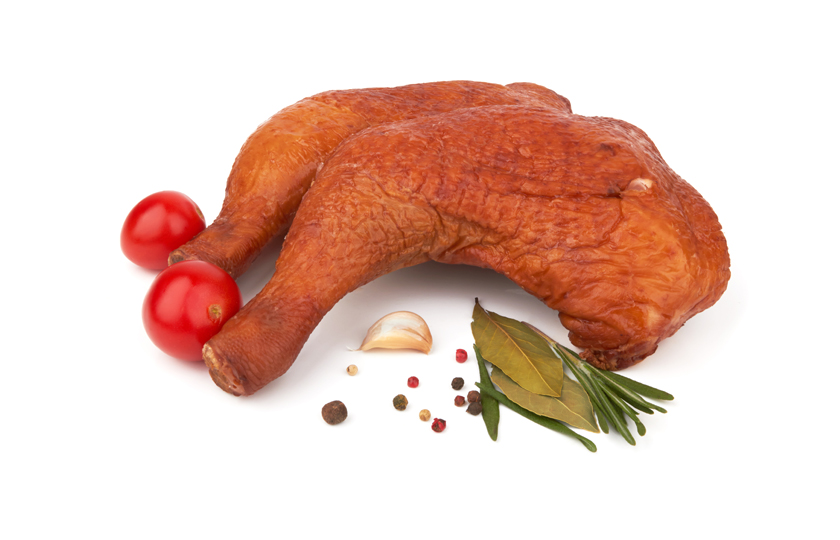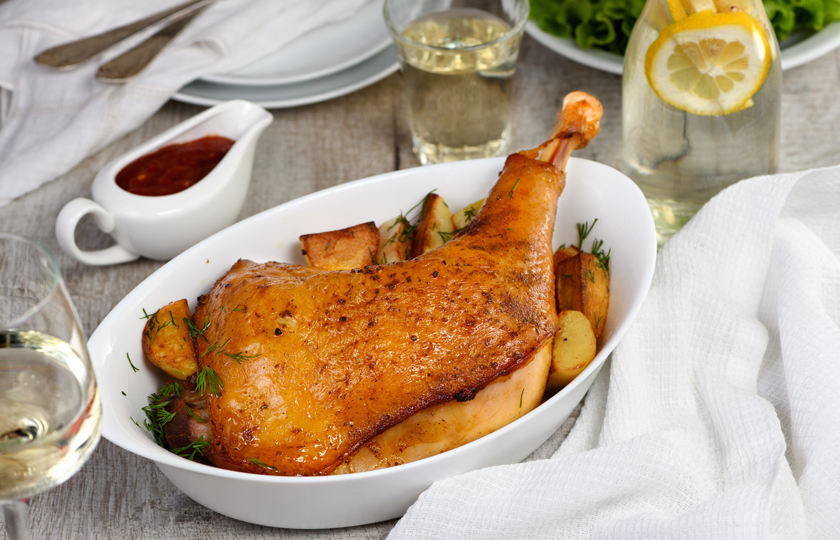Easily Reheat Your Leftover: How to Heat Up a Fully Cooked Smoked Turkey Leg

Holiday smoked turkey legs are always unforgettable, but how can you reheat leftover turkey legs to preserve their original flavor? Reheating fully cooked smoked turkey legs is an art that requires avoiding dryness while maintaining the aroma of the spices. Let’s explore how to perfectly reheat smoked turkey legs, ensuring every bite is filled with festive warmth.
How to Heat Up a Fully Cooked Smoked Turkey Leg?
Smoked turkey legs are made from fresh turkey legs that are brined and coated with spices before being smoked, creating a unique flavor. This preparation not only imparts rich aromas but also helps lock in moisture, making the meat tender. Here are some common methods for reheating fully cooked smoked turkey legs:
Oven Heating:
Preheat the oven to 160°C (325°F).
Place the turkey legs in a baking dish, skin side up, and add a small amount of broth. Cover with aluminum foil.
Heat for 25-30 minutes, ensuring the internal temperature reaches 74°C (165°F).
Microwave Heating:
Slice the turkey legs and place them in a microwave-safe dish, covering with plastic wrap.
Heat on medium-low power, checking every 1-2 minutes until heated through.
Slow Cooker Heating:
Add a small amount of broth to the slow cooker and place the turkey legs inside.
Set to low and heat for 2-3 hours, ensuring the temperature reaches 74°C (165°F).
Stovetop Heating:
Add a small amount of oil to a skillet and gently heat the turkey legs, turning to ensure even heating.
Cover with a lid to retain moisture.
Tips:
Check Temperature: Regardless of the heating method, ensure the internal temperature reaches 74°C (165°F) for food safety.
Avoid Overheating: Prolonged heating may dry out the meat, affecting its texture.
How do you heat up a turkey leg without drying it out?
The key to reheating turkey legs without drying them out lies in maintaining moisture and controlling temperature. Here are some effective methods:
Oven Heating:
Preheat: Preheat the oven to 160°C (325°F).
Prepare: Place the turkey legs in a baking dish, skin side up, and add a small amount of broth or water at the bottom.
Cover: Cover the dish with aluminum foil to prevent moisture loss.
Heat: Reheat for about 25-30 minutes, ensuring the internal temperature reaches 74°C (165°F).
Microwave Heating:
Slice: Cut the turkey legs into thin slices and place them in a microwave-safe dish.
Cover: Use a microwave-safe lid or plastic wrap to cover, retaining moisture.
Heat: Heat on medium-low power, checking every 1-2 minutes to avoid overheating.
Slow Cooker:
Prepare: Place the turkey legs in the slow cooker and add a small amount of broth or water.
Heat: Set to low and heat for 2-3 hours to keep the meat moist.
Stovetop Heating:
Heat: Add a small amount of oil to a skillet and gently place the turkey legs in, turning occasionally.
Cover: Use a lid to trap moisture and prevent drying.
Tips:
Use a Meat Thermometer: Ensure the internal temperature reaches 74°C (165°F) but avoid overheating.
Soak: Consider soaking the turkey legs in broth before reheating to enhance moisture.
Why Are My Smoked Turkey Legs Tough?
Smoked turkey legs can become tough for several reasons:
Overcooking: If the turkey legs are cooked for too long during smoking or reheating, the meat can dry out and become tough. It's important to remove the turkey legs once they reach an internal temperature of 74°C (165°F) to avoid overcooking.
Lack of Moisture: Insufficient liquid (such as broth or water) during reheating can cause the meat to lose moisture, resulting in dryness and toughness.
Improper Cooling: If the turkey legs are not cooled promptly after smoking, they can dry out, especially if exposed to air for extended periods.
Quality of Meat: Some turkey legs may naturally have a drier texture, particularly if they come from older birds.
Storage Issues: If the turkey legs are not stored properly, allowing air to enter can lead to dryness.
Improvement Suggestions:
Maintain Moisture During Heating: Use broth or water and cover with aluminum foil to prevent moisture loss.
Control Temperature: Use a meat thermometer to ensure the meat is heated to the appropriate temperature without exceeding 74°C (165°F).
Proper Storage: Seal leftover turkey legs to minimize air exposure and help retain moisture.
How Long to Reheat Smoked Turkey Legs in an Air Fryer?
Reheating smoked turkey legs in an air fryer typically takes about 10-15 minutes, depending on the size of the legs and the model of the air fryer. Here’s a detailed step-by-step guide:
Reheating Steps
Preheat the Air Fryer: Preheat your air fryer to 160°C (320°F).
Prepare the Turkey Legs: If possible, cut the turkey legs into smaller pieces to ensure even heating.
Place in Air Fryer: Arrange the turkey legs in the air fryer basket, making sure they are not overlapping to allow for proper air circulation.
Heating Time: Heat for 8-10 minutes, then check the internal temperature to ensure it reaches 74°C (165°F). If necessary, add another 2-5 minutes of cooking time.
Check and Turn: During the heating process, turn the turkey legs halfway through to ensure they heat evenly.
Additional Tips
Maintain Moisture: If you're concerned about dryness, you can spray a little water or broth on the turkey legs to help keep them moist.
Use a Meat Thermometer: Make sure to check the internal temperature to ensure food safety by reaching at least 74°C (165°F).
How to cook already smoked turkey legs in the oven?
Cooking smoked turkey legs in the oven is an excellent choice to ensure the meat stays moist and flavorful. Here’s a detailed guide:

Ingredients
Smoked turkey legs
Broth or water
Aluminum foil
Cooking oil (optional, for browning)
Steps
Preheat the Oven: Preheat your oven to 160°C (320°F).
Prepare the Baking Dish: Pour about 1/4 to 1/2 cup of broth or water into the bottom of a baking dish to help maintain moisture.
Place the Turkey Legs: Arrange the smoked turkey legs in the baking dish, ensuring they do not overlap.
Cover with Aluminum Foil: Cover the baking dish with aluminum foil to prevent moisture loss. This step is crucial for keeping the meat moist.
Cooking Time: Depending on the size of the turkey legs, cook for about 30 to 45 minutes. Regularly check the internal temperature during cooking.
Check Internal Temperature: Use a meat thermometer to ensure the internal temperature of the turkey legs reaches 74°C (165°F). If needed, you can remove the foil in the last few minutes to allow the surface to brown slightly.
Rest: After taking the turkey legs out of the oven, let them rest for about 5 minutes. This allows the juices to redistribute, keeping the meat tender.
Tips
Maintain Moisture: Using broth or water effectively prevents the meat from drying out.
Avoid Overcooking: Regularly check the temperature to ensure it doesn’t exceed the desired level, which could make the meat tough.
How Long to Cook Smoked Turkey Legs on the Stovetop?
The cooking time for smoked turkey legs on the stovetop typically depends on the size of the legs and the cooking method. Here’s a step-by-step guide:
Cooking Steps
Preheat the Pan: Heat a large skillet or wok over medium heat. If desired, add a small amount of cooking oil.
Add the Turkey Legs: Place the smoked turkey legs in the pan, avoiding overlap. If the pan is too small, cook in batches.
Cooking Time:
Searing: Cook each side for about 5-7 minutes until the skin is heated through and slightly browned. The total cooking time is approximately 10-15 minutes.
Add Broth: To keep the meat moist, you can add a small amount of broth or water while searing, and cover the pan with a lid to help heat and retain moisture.
Check Internal Temperature: Use a meat thermometer to ensure the internal temperature of the turkey legs reaches 74°C (165°F).
Rest: After removing the turkey legs from the pan, let them rest for 10-15 minutes to allow the juices to redistribute.
Tips
Maintain Moisture: Adding broth or water effectively prevents the turkey legs from drying out.
Avoid Overcooking: Regularly check the temperature to ensure the meat remains tender.























